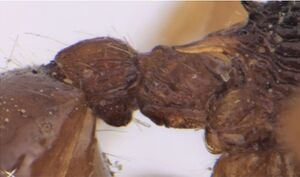Myrmecina narendra
| Myrmecina narendra | |
|---|---|

| |
| Scientific classification | |
| Kingdom: | Animalia |
| Phylum: | Arthropoda |
| Class: | Insecta |
| Order: | Hymenoptera |
| Family: | Formicidae |
| Subfamily: | Myrmicinae |
| Tribe: | Crematogastrini |
| Genus: | Myrmecina |
| Species: | M. narendra |
| Binomial name | |
| Myrmecina narendra Sheela, 2020 | |
The species is described based on a single worker as the three more specimens from the same collection are totally damaged. But the characters are very clear to indicate it as a new species.
Identification
Sheela et al. (2020) - Worker. This new species is similar to Myrmecina camellia in the presence of longitudinal striations on mesosoma and presence of dorsal propodeal teeth. But it differs from M. camellia in the absence of clypeal processes (weak clypeal processes present in M. camellia), prominent dorsal propodeal teeth (dorsal propodeal teeth weak in M. camellia), smooth, polished gastral dorsum (punctate gastral dorsum in M. camellia) and lateral keels on postpetiole not well developed (lateral keels on postpetiole well developed in M. camellia).
Keys including this Species
Distribution
Distribution based on Regional Taxon Lists
Oriental Region: India (type locality).
Distribution based on AntMaps
Distribution based on AntWeb specimens
Check data from AntWeb
Countries Occupied
| Number of countries occupied by this species based on AntWiki Regional Taxon Lists. In general, fewer countries occupied indicates a narrower range, while more countries indicates a more widespread species. |

|
Biology
Castes
Worker
 
| |
| . | |
Nomenclature
The following information is derived from Barry Bolton's Online Catalogue of the Ants of the World.
- narendra. Myrmecina narendra Sheela, in Sheela et al., 2020: 16, figs. 6-10 (w.) INDIA.
Unless otherwise noted the text for the remainder of this section is reported from the publication that includes the original description.
Description
Worker
Holotype worker. Length DPW - 0,32 mm, ED - 0,09 mm, HL - 0,84 mm, HW - 0,92 mm, ML - 0,99 PW - 0,65 mm, SL - 0,82 mm, TL - 3,4 mm , CI - 109, OI - 10,24, SI - 88,64.
Dorsum of head and mesosoma reddish brown; sides of mesosoma with yellow tint. Clypeus, mandibles, antennal hollows and its lateral parts, antennae (mostly scape) anterior collar of pronotum, propodeal spines, petiole and gaster honey yellow; legs and apex of gaster light yellow; mandibles, legs, pedicel and gaster with abundant, long erect and suberect hairs; pubescence not visible. Ground sculpture finely punctate on head, mesosoma and pedicel; head, and mesosoma coarsely longitudinally striate; mandibles and pedicel with weak striations; striations on head more or less straight but on mesosoma diverging towards anterior portion of pronotum; gaster, apical face of propodeum and legs smooth, polished.
Head posteriorly widely emarginated and posterior margin delineated by a transverse carina, beyond which occiput smooth; sides straight; clypeus medially depressed; anterior margin transverse, mandibles with two sharp apical teeth followed by a row of small denticles; antennae 12-segmented; antennal carinae short, posterior margin extending beyond level of anterior margin of eyes; scapes almost reaching posterior margin of head in front view. Mesosoma weakly convex in profile, without sutures on dorsum; narrowing posteriorly; ventral teeth on prosternum large and acute; pronotum broad, anterolateral corners angular dorsal propodeal teeth very prominent, straight and vertical, both teeth and spines broad at base, spines long, slightly bending outwards in lateral view; spines longer than distance in between them; legs crescentic. Petiole without a well-defined peduncle in front, node ring like; length, height and width almost equal; subpetiolar process present ventral tooth on postpetiole large and triangular, anterior face of petiole concave and nodes above weakly convex; post petiole broader than long, slightly broader than petiole; gaster broadly oval.
Type Material
Holotype: worker (Reg. No. 22929/H3), India: Manipur, S Vaojans, Churachandpur, 04.IV 1992, leg. A.K. Hazra and Party.
Etymology
The species is named after late Dr. T.C. Narendran, an outstanding taxonomist in Hymenopteran research in India.
References
- Aswaj, P., Anoop, K., Priyadarsanan, D.R. 2021. Description of two new species of ants of the genus Myrmecina Curtis, 1829 (Hymenoptera: Formicidae: Myrmicinae) from the Eastern Himalayas. Zootaxa 4990, 160–171 (doi:10.11646/zootaxa.4990.1.10).
- Sheela, S., Kazmi, S.I., Roy, S. 2020. Two new species of the genus Myrmecina Curtis, 1829 (Hymenoptera: Formicidae: Myrmicinae) from India. Far Eastern Entomologist 403: 13-19 (doi:10.25221/fee.403.2).

